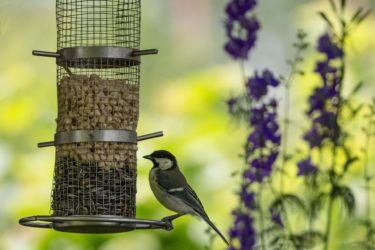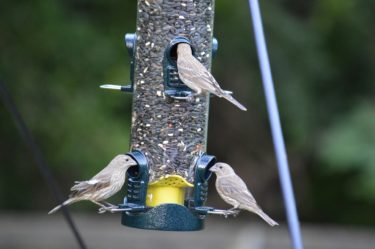One of life’s simple pleasures is to put a bird feeder in your garden and watch the resulting avian visitors. And it’s a simple pleasure that many of us indulge – just over half the nation fed garden birds during 2020. We are encouraged to do so by venerable organisations such as the RSPB, the BTO and The Wildlife Trusts and are told in so doing we are actively helping birds by providing them food that helps them through lean times and replacing food sources that are declining due to habitat loss.
Commercial bird food first hit British shelves in the 1950s and has grown to be an industry worth somewhere between £200 and £300 million each year. While it can be easy to think that your little feeder isn’t that important in the scheme of things, a 2009 paper by Zoe Davies and colleagues estimated that there was approximately one feeder for every nine feeder-using birds and up to 2,580 tonnes of food available from feeders at any one time. More recent estimates suggest there is a national average of 100 feeders per km2. Individually it may not feel like we are doing a lot, but collectively we are having a huge impact.
We are only just getting to grips with the extent of that impact, and a paper published earlier this year provides some compelling arguments that not all these impacts are positive, and in fact may be outweighed by the negatives. The paper by Jack Shutt and Alex Lees explores the research on “generalised provisioning”, the term used to describe the providing of food, water and shelter to broad groups of animals rather than targeted support for a specific species. Putting out bird food is an example of general provisioning.
There are many examples of targeted provisioning benefiting species and playing an important role in conservation efforts. Species that have benefited include kakapo (though improved diet also leads to an unwanted increase in male offspring), the Spanish imperial eagle, and the cape griffon. There are also examples of generalised provisioning benefiting species in terms of increased survival rates, particularly over winter, and improved health which leads to increased breeding success. The authors of the article acknowledge all these benefits, and more.

However, they also note that in recent years there has been an increased recognition that there can be unintended negative consequences to generalised provisioning. One of the most well-known is the spread of Trichomonas gallinae, a parasite found in pigeons which crossed into finches through contaminated bird feeders in 2005, resulting in, among others, a 66% population reduction of greenfinches in just 10 years.
While these negative direct impacts are concerning, the authors are more worried by the negative indirect impacts. These impacts are easier to miss, particularly as most studies are focusing on the impacts of generalised provisioning for the species taking advantage of it. But when the impacts of generalised provisioning are explored for the species who do not take advantage they are deeply troubling.
Ecological niches
The authors use the example of four species of British tits: the great tit, the blue tit, the willow tit and the marsh tit. All four are cavity nesting woodland birds that feed primarily on insects. On the surface there’s not much to tell them apart ecologically. So how do they all manage to coexist? This is where the concept of ecological niche comes in. A niche is the range of resources (primarily food but also things like shelter and availability of mates) and conditions (such as temperature, humidity and seasonality) that allow the species to maintain a viable population.
Each of the four tit species have subtly different niches. For example, marsh tits have a stronger beak than the others, allowing them to feed on tougher food resources. They also store food in caches to help them through lean times and are quicker at identifying ephemeral food sources. Meanwhile willow tits excavate their own nesting holes rather than relying on pre-existing holes as the others do, allowing them to breed in areas where the others cannot. While marsh and willow tits live in more marginal environments they are better able to cope with bad weather than blue and great tits, allowing all four species to exist in a balance that prevent any one from getting the upper hand.
But then along come well-meaning humans who put out bird feed and put up nesting boxes and suddenly that balance is upset. Blue tits and great tits happily use feeders and nest boxes and their populations have increased as a result. Over the last 25 years blue tits have seen a modest but respectable 1% increase in population size while great tits have seen a massive 38% increase, corresponding to 700,000 more pairs. In contrast, the marsh tit has declined by 53% and the willow tit by a staggering 87% over the same time period (you can explore population data on these species and many others at the BTO website). While the authors note that no direct empirical evidence exists to show that bird feeders are responsible for this decline, they explain the ecological pathways through which this can occur.
Co-occurring species within assemblages compete with each other for limited natural re- sources but coexist by exploiting subtly different niches and employing varying life-history strategies, each with associated costs and benefits. Provisioning may reduce or eliminate advantages from alternative life history strategies occupied by non-provisioned species, reducing the ability of these species to compete and coexist… Provisioned species could then outcompete competitors for natural resources due to the advantages gained from provisioning reducing the number of ecological niches available and impoverishing community biodiversity.
Their concern is that by providing bird feed, rather than sustaining and increasing bird diversity we are in fact decreasing it, as the same set of common and adaptable birds are being supported across the country to such a degree that they are suppressing the ability of other species to survive.

So, is it all doom and gloom? Are we not even allowed to enjoy feeding birds now? Fortunately, not quite. The authors suggest that if we want to encourage birds we should do so primarily through wildlife gardening, which has the added benefit of helping more than just birds. They also recommend that if we do want to feed the birds we should only do so when it is actually needed, rather than providing food year-round.
I love watching birds on my feeders. Reading this paper and those that support its conclusions I found myself wondering if I can still justify that hobby. But I remembered that studies like this aren’t trying to shame us or make us feel bad for wanting to engage with nature. They aren’t saying we need to stop feeding the birds, just that we need to be more careful in how we feed them. So next time you see your feeders empty, ask yourself if they really need refilling right away. And if they don’t, please give them a good clean!



